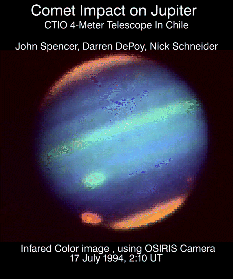

This true-color IR image shows the aftermath of the impacts of several of the fragments of Shoemaker-Levy 9 with Jupiter. The image is a composite of three IR filters (2.3, 1.7, and 1.58 microns) which are shown here are red, green and blue.
The impact sites are the small red/orange spots at high southern latitudes: a bright one (A) visible rising on the limb to the left, and a much fainter one (D) setting on the right. The impact sites are clearer an an accompanying greyscale image, and are explained in its caption. Most of Jupiter's disk appears blue because is it brightest in the 1.58 micron filter where methane absorption is not significant. The great red spot actually appears green in this composite, as it quite prominent in the 1.7 micron wavelength range. Jupiter poles are capped with a high haze, appearing orange in this image. The polar 'hoods' are high enough to reflect sunlight at in these long-wavelength methane absorption bands.
Technical details: Images taken between 2:06 and 2:18 UT on July 18, 1994, with the Ohio State Infrared Imaging Spectrometer (OSIRIS) at the 4-meter telescope of the Cerro Tololo Inter-American Observatory in Chile, by John Spencer (Lowell Observatory), Darren DePoy, Jay Frogel (Ohio State University), and Nick Schneider (CU/LASP).